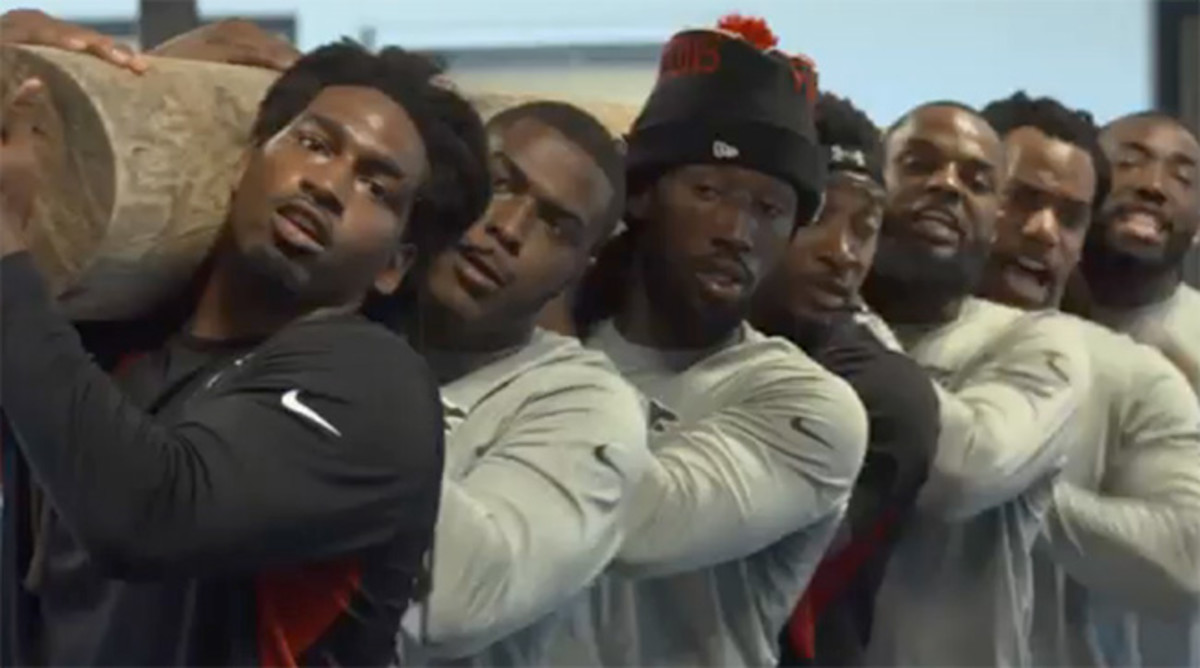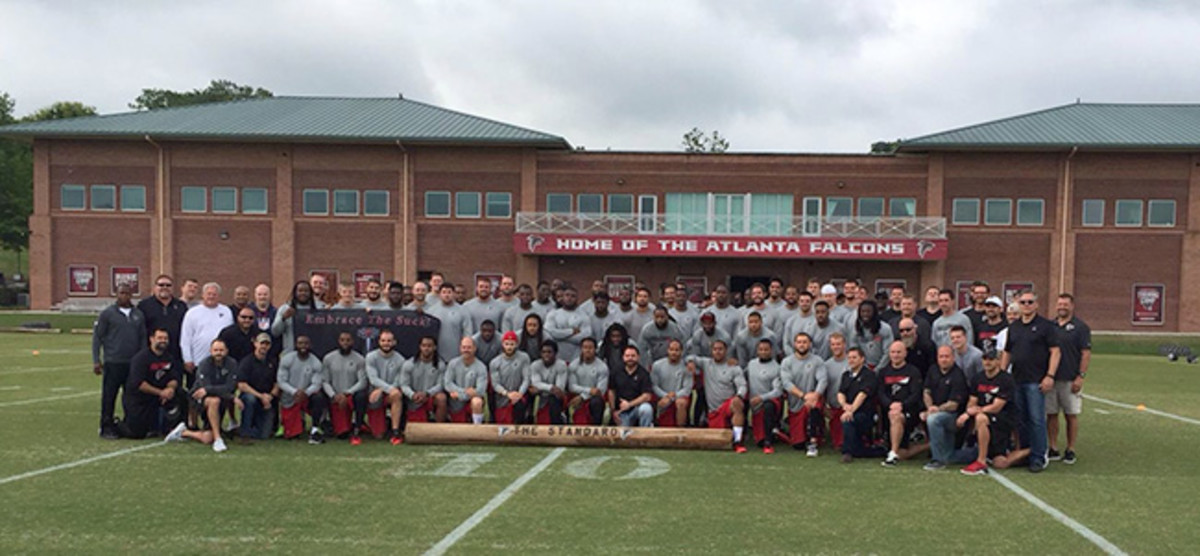When Falcons Train With SEALs

As he drove to the team facility in Flowery Branch, Matt Ryan expected the usual routine: meetings, followed by a lift. After all, it was only the second week of offseason workouts for the Falcons. But when the quarterback walked into a meeting room that Monday morning and saw the seven Navy SEALS at the front of the room, he knew it was going to be a different kind of week.
“We’ve had people come in for one day and talk and then leave,” Ryan says. “Some are good and some are not so good, but pretty quickly I found out that this was going to be more intense than the other things I’ve been a part of.”
For the next four days, the retired SEALs put Falcons players through a combination of physical training and classroom sessions, focused on developing some of the core tools of SEAL training: mental toughness and resilience, teamwork and stress management.

Head coach Dan Quinn kept the SEALs training week a secret from players and even coaches until that morning. “The coaches knew something was going on the next week because I told them there would be nothing football-related for four days,” Quinn says. “Their antennas were up because it went all the way down to how we dress, and what the locker room pick up looked like.”
Falcons director of sports medicine and performance Marty Lauzon and general manager Thomas Dimitroff had brought the idea to Quinn, who was just coming off his latest offseason project—overhauling the locker room to create a more open space and foster a team connection by mixing up locker placement with different position groups and ages. Quinn was searching for the next unique idea to improve his team, and training with SEAL veterans seemed like a perfect fit. “Our worlds are really different in terms of Special Operations and the things that they do,” Quinn says, “but the connection that takes place within the team, that part, they’ve nailed.”
The week was set up by Acumen Performance Group, a consulting firm founded by 20-year Naval Special Warfare veterans Bill Hart and Scott Brauer. Among past clients are the Pittsburgh Pirates, Northwestern football and one NBA team (they won’t disclose which one while that team’s season is still ongoing). The Falcons are the first NFL team they’ve worked with.
Hart and Brauer emphasize that APG does not represent the SEALs, and that their training is not SEAL training. The workout the Falcons went through was nowhere near the SEALs’ “Hell Week” experience. For clients with multi-million dollar contracts, safety dictates the limits of the workout.
The SEALs began by asking the players to do 10 push-ups. “We’re dealing with professional athletes, can everybody in the room do 10 push-ups? Of course everyone can,” Hart says. “But can everybody do 10 push ups perfectly in unison counting off? Now it gets a little more tricky.” And then it got trickier, the SEALs yelled at the players to make them nervous and simulate a high-stress environment. Performance under pressure. “We did a lot of push-ups and we learned how to do them really good,” Quinn laughs.

Later, players were split into “boat crews” of six, each crew asked to carry a 240-pound log for an undetermined amount of time. The players weren’t told how far or for how long they’d have to carry it.
“That’s part of what makes it so difficult is the unknown, not knowing when it is going to end,” says Ryan, who caught a break when he and fellow QB Matt Schaub were paired with guards Ben Garland and Mike Person, defensive lineman Tyson Jackson and linebacker Tyler Starr due to their similar heights. (“I was definitely one of the weakest guys carrying our log,” Ryan adds.) Garland, an Air Force graduate, had experience in this kind of training. “He had some old songs he would sing when he was going through basic training,” Ryan says. “He was like the ringleader in our little boat team. He was really good and helped us take our minds off of what we were doing.”
Even Quinn and Atlanta’s coaches put in time with the logs. “It’s one thing for the players to be well connected, but I thought it was really important for our staff too,” Quinn says. “We didn’t show you that video, thank goodness, it would look rough.”
Many of the physical exercises were head-to-head battles between the crews. Receiver Julio Jones left the week with bragging rights after his crew won several competitions. “It’s all about communicating under pressure when you are fatigued,” Jones says. “And that part of it pertains to football. When you are on the field and you are tired and fatigued what are you going to do? Are you going to let your brothers down?”
The classroom sessions played as big a role as the physical training. The SEALs told stories to illustrate the lessons in decision-making, teamwork and goal-setting. There were stories about life or death situations they went through while on deployments in Iraq and Afghanistan.
“The bravery that they have and their discipline and attention to detail, to me it was eye opening,” Ryan says. “We would see guys at 3:30 in the afternoon in our facility just talking with the SEALs. That doesn’t happen this time of the year. Usually when you are done, people are out of here pretty quickly.
When asked which players stood out as leaders in the four days of training, Quinn quickly rattles of 15 names and could keep going. “We learned that leadership comes from all levels,” he says. “Just because a player is going into his second or third year doesn’t mean he isn’t going to have significant leadership value here.”
The team is still in transition heading into Quinn’s second season, and the training program created a closer-knit group. Bill Golden, an APG trainer and Special Operations Forces veteran says, “I wouldn’t bet against the Falcons this year, these guys got it.”
